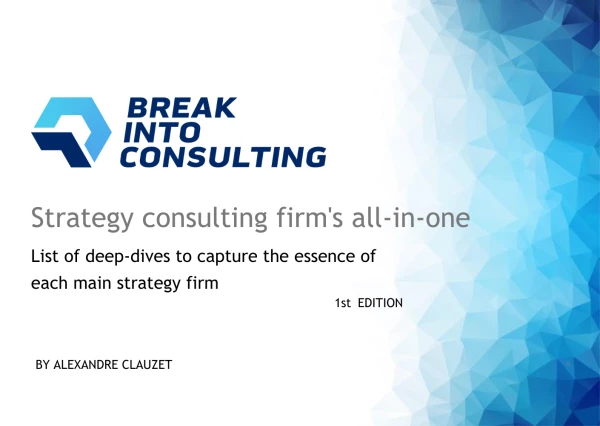How often is some exhibit information not needed? Sometimes I spend time on details that don't actually help solve the case. But I'm unsure how to identify the relevant versus irrelevant information.
Useless information on exhibits


Almost always. :)
It is the very reason why you get presented with an exhibit - to test your ability to identify the relevant information and how it helps to answer the core question. The classical mistake committed by many many candidates is to "get lost" in the exhibit and try to come up with all sorts of insights - completely detached from the context.
The secret to success is simple - keep laser focus and always ask yourself, what is the question that you are trying to answer, and which information on the chart can help you towards an answer.
Cheers, Sidi
___________________
Dr. Sidi S. Koné
Former Senior Engagement Manager & Interviewer at McKinsey | Former Senior Consultant at BCG | Co-Founder of The MBB Offer Machine™

What makes information useful or not is whether it can help answer the question at hand. That is why it is important to take 1-2 mins to examine the exhibit first and then decide what is relevant to you.

Hi there! It's not uncommon for exhibit information to contain both relevant and irrelevant details. As a strategy consultant, it's important to efficiently identify the key insights that will help solve the case. To distinguish between relevant and irrelevant information, I recommend taking the following approach:
Understand the case objective: Clearly define what problem you're trying to solve or what decision you're trying to make. This will provide you with a framework to determine which information is necessary.
Focus on the case context: Consider the industry, market, and specific situation described in the case. This will help you filter out information that is not directly related to the problem at hand.
Look for patterns and trends: Analyze the exhibit information for any recurring themes, significant changes, or outliers that could impact the case. These patterns are more likely to be relevant and should be given priority.
Prioritize key metrics: Identify the key performance indicators or metrics that are crucial to understanding the situation. Focus on these metrics to gain insights and make informed recommendations.
Use your judgment: Trust your instincts and professional judgment to determine the relevance of information. If something seems tangential or doesn't align with the case objective, it's likely not needed for solving the case.
Remember, practice makes perfect. The more you practice analyzing exhibits and solving case studies, the better you'll become at quickly identifying the relevant information. Good luck!

Yes there is but that does not mean you need to have a sharp eye and still catch the relevant details that might be hidden (e.g., footnotes can sometimes make or break a case), Warm regards, Frederic

Of course there's information that is not useful - that's why one uses “action titles” on slides, and that's why we need analysts… to draw the insights from information.
Now, how to distinguish what is relevant from what is not? Try this: instead of starting with the data, start with the problem you are trying to solve, i.e., don't think about what is interesting and smart, but instead on which information will help the client make a decision. That is the ultimate criteria.
If it moves you towards a recommendation, it is useful. Otherwise it is not, no matter how interesting it is.

Great question! I was just discussing this with a candidate the other day.
In short, when you look at the exhibit, you need to figure out what are the most important 2-4 insights and then communicate them in the order of their magnitude (i.e., prioritization).
Practically, what that means, is that you don't need to speak about everything. Some things might be irrelevant. Other things might be too small to be worth discussing. And other things might be there just to confuse you.
Best,
Cristian
———————————————
Practicing for interviews? Check out my latest case based on a first-round MBB interview >>> SoyTechnologies

Hi,
As a former manager in consulting, I've often seen the flipside from my consultants in my team, when their slides have alot of information that are not related to the objective or do not have insights ;)
Ultimately what is relevant is determined by what question you are trying to answer. If you are clear on that, it will help you determine what is relevant or not.
All the best!

Hi,
The purpose of any case interview is to simulate a real consulting project. On a real consulting project there can be plenty of information, irrelevant to your analysis.
Therefore, not all the data handed out to you during a case interview will be relevant.
Remember to keep the initial hypothesis in mind and only search for the data that can prove or disprove it.
Good luck!
Nick

Hi there,
1) How often is some exhibit information not needed?
It is quite common that some information is useless in a graph. This is a way to replicate what actually happens when doing research in real life.
2) Sometimes I spend time on details that don't actually help solve the case. But I'm unsure how to identify the relevant versus irrelevant information.
I would recommend the following steps to be able to identify relevant information.
1. READ THE GRAPH
- Ask for some time to understand the graph. Usually 30 seconds are enough, but there is no hard rule.
- Summarize the graph. Read in particular the graph title, the legend, and the footnote. Candidates quite often skip this part and then make mistakes. This is important to be sure you have a clear idea of the graph and don’t skip relevant information.
2. ANALYZE THE GRAPH AND FIND THE KEY INSIGHTS
- Repeat the question. Some candidates don’t repeat the question and then answer the wrong one. If you repeat it, you can be sure that you will answer what was asked. Based on the objective, you should be able to identify the relevant information out of those you summarized in Point 1.
- Provide an analysis related to the question. Identify the key insights of the graph based on the question. This is the most challenging part of graph analysis to master, as it is different in every chart. You can improve it with drills on your own or with coaching.
3. PROPOSE THE NEXT STEPS
- State your hypothesis or suggestion on what to do next. Present what should be done next to help further the client reach the goal.
- Ask a question/propose an analysis related to what is needed to move forward. This will show you are able to drive the case forward.
Best,
Francesco

Hi there,
Common sense can be your best ally in these situations. Here are some tips to help you decide whether the exhibit information is relevant or not:
Relevance to the Case Objective: Always keep the primary objective of the case in mind. Does the information directly contribute to solving the case or achieving the intended goal? If not, it may be less relevant.
Cross-Verification: Consider if the information can be cross-verified or corroborated with other evidence. Reliable information is typically supported by multiple sources (I.e. information provided by the interviewer)
Impact: Think about how the information might impact the case's outcome. Does it significantly change the understanding of the situation?
Focus on Key Questions: Keep a set of key questions in mind when reviewing information. If it doesn't help answer these questions or clarify key issues, it may be less relevant.
Occam's Razor: Remember Occam's Razor, which suggests that the simplest explanation is often the best. Unnecessary details can overcomplicate a situation and sometimes the interviewers will test that as well.
Feel free to reach out for more information. Hope this is helpful.
Thanks,
Aude

Hi there,
Love this question!
When you think about it, doesn't real life have useless information? (e.g. about half of the case prep resources out there :P)
In consulting you'll get tons of useless info.
I don't like the phrase “how often”. Sometimes never. Sometimes always. Every case/interviewer is different. Be ready for anything rather than playing this proabilities game.
Rather, be objective-driven. Always know what your looking for, what the end goal is. If your data does NOT result in an insight that DIRECTLY affects our question/goal, then it is usless information.
Make sense?
Always be objective-driven.

Whether or not information is useful/useless depends on the context in which the exhibit is provided:
- Direct question: If the exhibit is provided to solve a particular problem, there is potentially such a thing as useless information. → In this case, you will need to be very targeted and isolate what's important. If you struggle with this, I would consider some coaching. This is impossible to solve in a Q&A.
- No direct question: Often times, exhibits are provided without a particular question and the interviewer simply asks “what can you take away from this?". This is almost always the case in McKinsey interviews, where candidates can derive different conclusions (with a certain overlap, of course) from the same exhibit, depending on whether they connect the dots with the prompt or what's going on in the world, etc. So long as you're able to synthesize any insights and don't just state the obvious, you're fine. → Once you're done with your analysis, you're then often asked a specific question (see #1).
If you need help with any of the above, feel free to give me a shout.
Best of luck!
Moritz
~~~~~~~~~~~~~~~~~~~~
>> Need a senior McKinsey coach? See my profile in a nutshell
>> Need real McKinsey cases? See two real examples with Zero Carbon Mine (hard) & Car Convenience (Intermediate + brand new)

Hi there,
Very common. When facing a graph in a case interview you need to follow a structured approach:
- Read and understand the graph. Ask your interviewer for some time to understand everything before talking. Summarize out loud the graph, reading the title, legend, axis and footnote
- Analyze the graph and extract insights for the case. Start with simpler and direct insights. Follow with trends and more complex relationships across data points.
- Propose justified next steps. State your hypotheses for the case based on the graph insights. Justify all your suggestions.
Happy to keep talking about this in private, just send me a message.
—
Check out my latest case based on a real MBB interview: Sierra Springs












